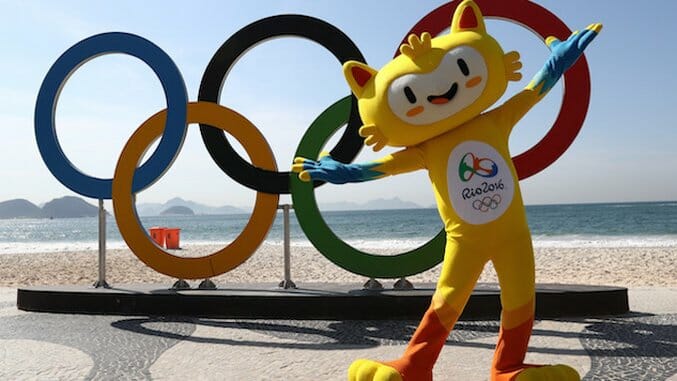
If you see a group of men capering about in zany costumes at the Olympics, it might be the Norwegian men’s curling team. If you notice some aggressively colorful, aggressively friendly locals in zip-off pants, those are the Olympic volunteers. BUT if you see a vaguely humanoid, brightly-colored figure that doesn’t quite fit into either of those categories, it’s probably an Olympic mascot.
Why has every Olympic Games since 1972 had at least one mascot (some have had as many as five)? Olympic.org doesn’t say much about their origins, just that they give “concrete shape to the Olympic spirit” and that the first official one was drawn up at the Munich Games Organizing Committee’s Christmas Party. That means mascots might be the only recorded instance of an idea someone had at an office Christmas party that people still thought was smart the next morning.
That mascot was Waldi, a cartoon dachshund created for the Munich Olympics. His colorful coat was in keeping with the “rainbow games” theme, but his West German designer consciously avoided black and red, the colors of the Nazi Party. Yet Waldi was not immune from controversy. Displeasure at the ballooning cost of the games led a local artist to create an unofficial poster depicting Waldi relieving himself on the Olympic Tower.
Early mascots stuck to this straightforward formula: Montreal’s Amik, a beaver whose name means “Beaver,” was basically a black circle wearing an Olympic sash. Innsbruck’s Schneemann was a (somewhat creepy) snowman with a hat. Lake Placid’s Roni the Raccoon was equally straightforward.
The 1980 Moscow Olympics’ Misha was the first mascot to steal the show. An adorable bear cub, chosen specifically to combat the menacing “Russian Bear” image commonly used in the West, he warmed Russian hearts as the host nation won its most medals ever thanks to the U.S.-led boycott. Misha brought fans to tears and shed one himself as he was released, in giant inflatable form, at the closing ceremonies.
But his story was far from over. Still a national symbol, he met beloved American rodent Mickey Mouse (known locally as Mikki Maus) for a summit in Red Square in 1988, and thus the process of healing between our two nations began.
Misha was also the first mascot to appear on a slew of merchandise. Starting with collectible pins and plush animals, Olympic merchandise now ranges from commemorative backpacks to 3D puzzles to The Official Boomerang of London 2012, and mascots have become key components of each Games’ unique brand.
Even noted anti-consumerist Lisa Simpson got sucked into the merchandising craze, developing an addiction to collectible mascot pins in a 2010 episode of The Simpsons. The organizers of London 2012 charged schools up to £850 for a visit from their mascots, whom we’ll get to in a minute. Mascots have also starred in several video games, starting with 1995’s Izzy’s Quest for the Olympic Rings.
The natural reaction to all this commercialization, of course, was Fatso the Fat-Arsed Wombat. Fatso was the brainchild of two Australian TV hosts who were fed up with seeing the mascots of the Sydney 2000 games – Olly, Syd, and Millie – everywhere they looked. Their unofficial mascot, whose name pretty much tells you all you need to know about him, was arguably more popular than the official ones. One of only two plush Fatsos ever made – remember, this was a principled stand against commercialization here – found its way onto the podium with the gold medal-winning Australian men’s 4×200 relay team.
Luckily for Sydney, Atlanta had staked a nearly-unbeatable claim to the title of Worst Mascot four years earlier. Izzy, AKA WhatIzIt, was a blue blob with high-top sneakers and star-shaped pupils, and he looked every bit as disorienting as that sounds. His dynamic, computer-generated form and detailed backstory (he left his home and girlfriend in a world inside the Olympic flame in search of… glory, presumably) were supposed to make him the mascot of the future, but he is mostly remembered as that thing that looked like a blue sperm.
Olympic committees were wary of going back down the WhatIzIt road for many subsequent games, sticking to animals and cuddly humanoids and associating them more closely with their Paralympic counterparts. London 2012, however, returned to the abstract with the Olympic/Paralympic duo of Wenlock and Mandeville, enchanted drips of steel who, frankly, also kind of looked like sperm.
Then-mayor of London and former European Boris Johnson hailed the pair, saying, “It’s hard to imagine a mascot more in tune with the times.” That wasn’t necessarily a good thing – the characters’ eyes were cameras, an ominous reminder of London’s not-un-Orwellian surveillance network that earned them the nickname “My Little Drony.”
Rio 2016 introduces us to Vinicius and Tom, amalgamations of Brazilian fauna and flora, respectively, who are named for famous Brazilian musicians and lyricists and bare resemblances to characters from Adventure Time. Their backstory – they were born from the joy of locals after they learned Rio would host the games – might not stand up to scrutiny, but it’s admirable that their creators managed to go abstract without it getting weird.
Vinicius and Tom have already arrived in Rio, with merchandise bearing their images soon to be ubiquitous. The Rio 2016 website projects a profit of $288.8 million in retail sales during the Games. So while the athletes may be competing for glory alone, the mascots keep raking in the cash.